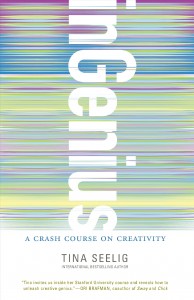When the advance copy of Tina Seelig’s inGenius: A Crash Course on Creativity came across my desk, I couldn’t wait to read it. Read her book and you will find yourself on the front row of her always-filled class on innovation. It’s a practical guide helping anyone improve his or her creativity. Tina Seelig is the director of the National Center for Engineering Pathways to Innovation and the executive director of the Stanford Technology Ventures Program. In addition, she has a Ph.D. in neuroscience from Stanford University Medical School.
Dr. Seelig recently answered a few questions for me about her work.
Are we born with a creative gene or are we able to learn it as a skill?
Our brains are built for creative problem solving, and it is easy to both uncover and enhance our natural inventiveness. The human brain evolved over millions of years from a small collection of nerve cells with limited functionality to a fabulously complex organ that is optimized for innovation. Our highly evolved brains are always assessing our ever-changing environment, mixing and matching our responses to fit each situation. Every sentence we craft is unique, each interaction we have is distinctive, and every decision we make is done with our own free will. That we have the ability to come up with an endless set of novel responses to the world around us is a constant reminder that we are naturally inventive.
You teach that we need to shift our frame of reference in order to see things from a new vantage point. Do you have any suggestions on how to make this shift?
You can look at every situation, every challenge, and every opportunity in the world from different angles, from close up, from far away, from upside down, and from behind. You can also look at them from different individuals’ points of view. For example, how would a child or a senior see the situation? What about an expert or a novice, or a local inhabitant versus a visitor? A wealthy person or poor one? A tall person or a short one? Each angle provides a different perspective on the situation and unleashes new insights.
It is important to keep in mind that we are creating frames for what we see, hear, and experience all day long, and those frames both inform and limit the way we think. In most cases, we don’t even think about the frames—we just assume we are looking at the world with the proper set of lenses. However, being able to question and shift your frame of reference is an important key to creative problem solving. Those who do this fluidly come up with fresh and fruitful ways of looking at challenges.
I really appreciated the concept you called “creative procrastination” to build up “creative pressure.” Explain that concept and how you can use it to your advantage.
Every environment has constraints. They include some combination of time, money, space, people, and competition. These constraints sharpen your imagination and enhance innovation. Constraints are a tool that can and should be modulated up and down to catalyze and compound creative energy. For example, when we have problems to tackle, we often wait to start until we have less time than seems possible to complete the task. This is very common with students who wait until the last minute to start their homework. I call this creative procrastination. They are building up the creative pressure which they use to propel them through the project. Even when you have an abundance of resources, it is valuable to consider how you would tackle the same challenges without them.
Failure is often important to achieving your ultimate goal. You discuss experimentation and how it isn’t always supported in various work environments. How can organizations help foster a culture to encourage creative thinking?
The best ways to foster a culture of creativity involve encouraging lots of experimentation. The key is to get concepts out in front of others as soon as possible so that everyone gets rapid feedback on their ideas. The longer you work on an idea, the more wedded to it you become. Therefore, you need to be encouraged to show your work to others, and to get their comments, before the ideas are hard to release if they aren’t working.
Experiments provide essential information—whether they work out as you had hoped or not. In fact, failed experiments are incredibly valuable in that they help close off paths that aren’t viable. Of course, nobody wants to fail, nor should they. But failure is an inevitable part of the creative process when you are doing things that haven’t been done before. As Henry Ford is claimed to have said, “Failure is only the opportunity to begin again more intelligently.”
I love the examples you give in your book about students wanting to get into your innovation classes at Stanford. Attitude plays a huge role in success. How have you seen belief make a difference in someone’s success?
Your attitude is the spark that jump-starts your creativity. That is, your mind-set is a key determinant in how you interpret and respond to situations. So many people give up long before they find creative solutions to their challenges—big and small—even when the answers are right in front of them because they don’t have the confidence that the problems can be solved. Essentially, if you believe something is possible, then it is.



